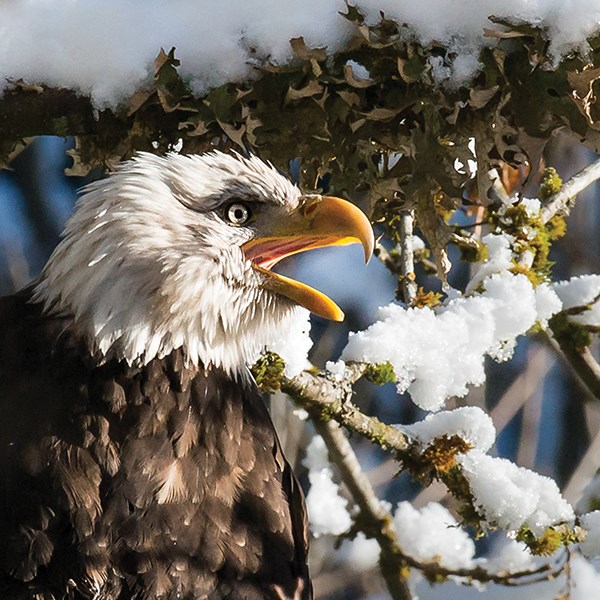For Thor Froslev, the eagles are a barometer of the health of the local environment, especially the size of the salmon run.
He points to the activities such as a fish farming and the spread of sea lice as causes for the decline of wild fish stocks, and of wintering eagle populations
“We know it because the eagles are starving,” he said on the morning of the 30th annual eagle count in Brackendale.
It was no surprise when by mid-afternoon, once the last team of volunteers returned to headquarters at the Brackendale Art Gallery, which Froslev operates with wife Dorte, the annual event turned up the smallest count ever. At 411, it marked the first time the tally came in at fewer than 500.
While some fluctuation can be expected in light of four-year salmon cycles, the low number is part of the trend of declining eagle numbers in recent years. With the exception of 2014, when fish stocks were high, and the eagle count was 1,617, the total has been fewer than a thousand ever year since 2008. In the decade previous, counts came in between approximately 1,300 and 2,400. The peak year was 1994 when 3,769 of the birds were counted.
Last year, the count was low too, at 697, though a terrible winter storm made visibility poor and also meant fewer volunteers.
“You couldn’t see the other side of the river,” Froslev said.
This year, the weather was cold but clear, and they had more volunteers, 61 compared with 55. Some volunteers suggested the snow on the trees this year made spotting the birds harder, while others said heavy rains in the late fall washed salmon carcasses out to sea, reducing the food supply for the eagles.
At the start of Sunday morning, volunteers received their packages outlining what they need to do and where they would be counting from coordinator Rachel Shephard.
The volunteers usually go out in groups of two or three, sometimes four, to a set area to note the number of adult and immature eagles in the area.
The teams generally have binoculars as an aid, though as Shephard points out, eagles are often easier to spot than many birds, not simply because of the white feathers of the adults but because of their massive size.
“The eagles are pretty big, so generally you can see them with the naked eye,” Shephard said.
Many of the volunteers have taken part for years and some also are avid birders, used to spotting avian life. However, identifying eagles is relatively easy for new volunteers.
“It’s a little different than the monthly bird counts and the Christmas bird counts in that eagles are easier to identify,” she added.
This year marked the 30th anniversary of the event.
For Froslev, the idea was as much common sense as anything. At the time, he noticed some wildlife officials conducting a count and how they gathered out in a parking lot at the start and at the end, even in the midst of a downpour. For him, it was simply a matter of opening up the doors to the Brackendale Art Gallery as a gathering point for the eagle counters each January.
He remains concerned about the lack of fish and what this means to the eagle population.
“It’s worrisome,” he said.
If the numbers are a worry, Froslev still sees something positive in getting the community to take part in the event, and regardless of the weather, he says the pleasure the volunteers take is obvious when they return to the art gallery at the end of the day.
“After they come back from counting, they’re grinning from ear to ear,” he said.



